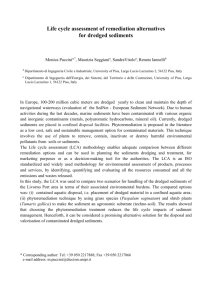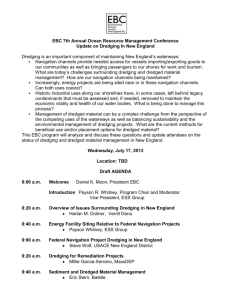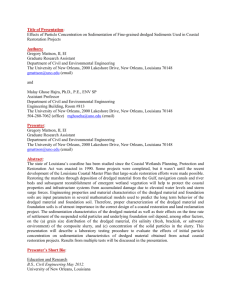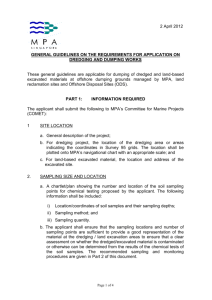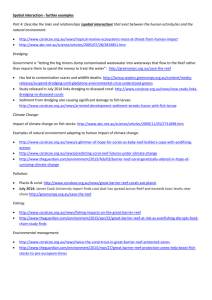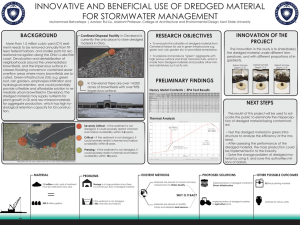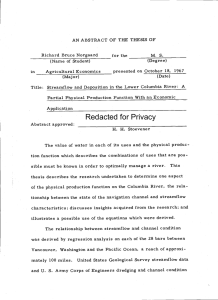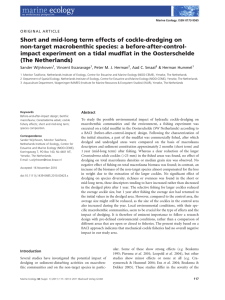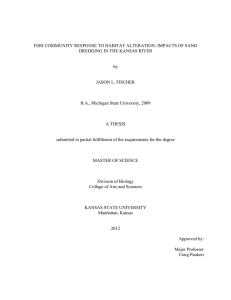texas habitat protection advisory panel
advertisement
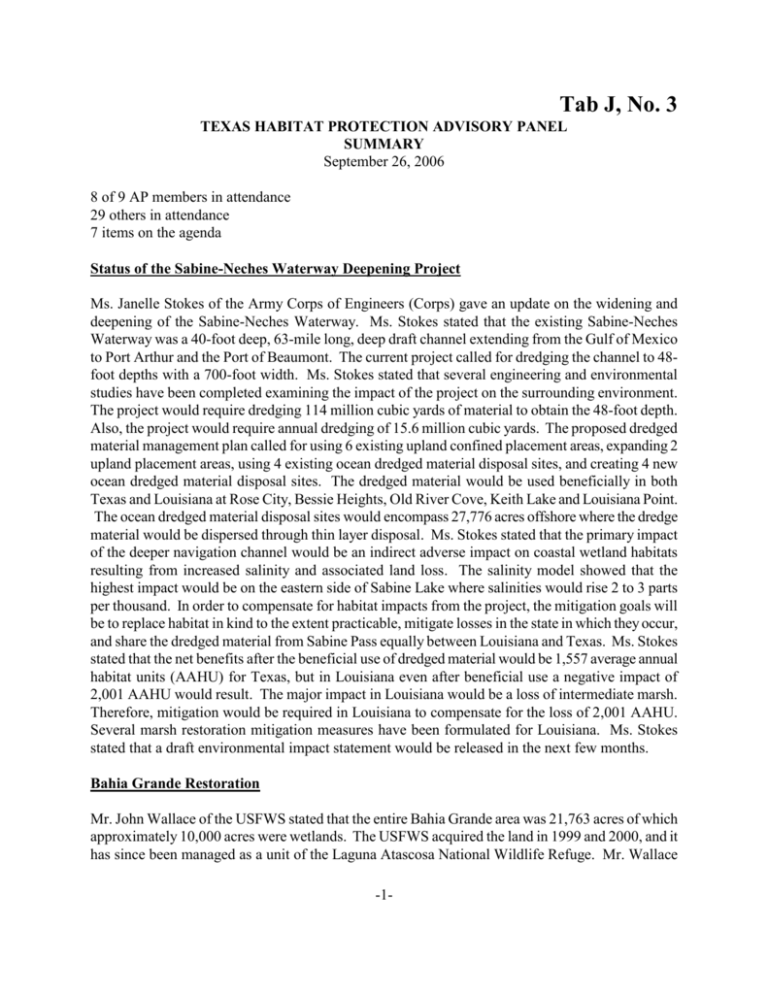
Tab J, No. 3 TEXAS HABITAT PROTECTION ADVISORY PANEL SUMMARY September 26, 2006 8 of 9 AP members in attendance 29 others in attendance 7 items on the agenda Status of the Sabine-Neches Waterway Deepening Project Ms. Janelle Stokes of the Army Corps of Engineers (Corps) gave an update on the widening and deepening of the Sabine-Neches Waterway. Ms. Stokes stated that the existing Sabine-Neches Waterway was a 40-foot deep, 63-mile long, deep draft channel extending from the Gulf of Mexico to Port Arthur and the Port of Beaumont. The current project called for dredging the channel to 48foot depths with a 700-foot width. Ms. Stokes stated that several engineering and environmental studies have been completed examining the impact of the project on the surrounding environment. The project would require dredging 114 million cubic yards of material to obtain the 48-foot depth. Also, the project would require annual dredging of 15.6 million cubic yards. The proposed dredged material management plan called for using 6 existing upland confined placement areas, expanding 2 upland placement areas, using 4 existing ocean dredged material disposal sites, and creating 4 new ocean dredged material disposal sites. The dredged material would be used beneficially in both Texas and Louisiana at Rose City, Bessie Heights, Old River Cove, Keith Lake and Louisiana Point. The ocean dredged material disposal sites would encompass 27,776 acres offshore where the dredge material would be dispersed through thin layer disposal. Ms. Stokes stated that the primary impact of the deeper navigation channel would be an indirect adverse impact on coastal wetland habitats resulting from increased salinity and associated land loss. The salinity model showed that the highest impact would be on the eastern side of Sabine Lake where salinities would rise 2 to 3 parts per thousand. In order to compensate for habitat impacts from the project, the mitigation goals will be to replace habitat in kind to the extent practicable, mitigate losses in the state in which they occur, and share the dredged material from Sabine Pass equally between Louisiana and Texas. Ms. Stokes stated that the net benefits after the beneficial use of dredged material would be 1,557 average annual habitat units (AAHU) for Texas, but in Louisiana even after beneficial use a negative impact of 2,001 AAHU would result. The major impact in Louisiana would be a loss of intermediate marsh. Therefore, mitigation would be required in Louisiana to compensate for the loss of 2,001 AAHU. Several marsh restoration mitigation measures have been formulated for Louisiana. Ms. Stokes stated that a draft environmental impact statement would be released in the next few months. Bahia Grande Restoration Mr. John Wallace of the USFWS stated that the entire Bahia Grande area was 21,763 acres of which approximately 10,000 acres were wetlands. The USFWS acquired the land in 1999 and 2000, and it has since been managed as a unit of the Laguna Atascosa National Wildlife Refuge. Mr. Wallace -1- stated that in the past the Bahia Grande area was a source of blowing dust that affected the Port Isabel and Brownsville area. Historically the Bahia Grande area was an estuary that was very productive. This changed when the Brownsville Ship Channel was dredged in the 1930s and cut off the area’s hydrologic connection. The restoration goals for the area have been to provide nursery areas and habitat for aquatic organisms such as shrimp, crabs, and finfish, to provide habitat for resident and migratory wildlife such as water birds and waterfowl, to reduce windblown dust, and to provide increased public recreation areas. In order to accomplish these goals, the USFWS decide to dredge three canals within the area to restore hydrologic connectivity to the area. The first canal was a 150 foot wide by 2,300 feet long canal from the Brownsville Ship Channel into the area. This canal was opened in July 2005. Mr. Wallace stated that the Bahia Grande area now contained water, but that salinities were too high to support fish and wildlife. He stated that additional canals should help with tidal exchange and reduce salinity. Deepening of the Matagorda Ship Channel Mr. Mark Mazoch of URS Corp stated that 16,500 jobs were connected to the Matagorda Ship Channel and that this represented over $1 billion per year in wages and salaries. He reported that it was currently the shallowest ship channel in Texas with a depth of 36 feet. The new proposed channel would be 44 feet deep with a 400 feet bottom width. Mr. Mazoch reported that estimated new dredging would be 46.5 million cubic yards of sand and clay with an estimated 50 years of maintenance of 257 million cubic yards. Direct impacts of the project would include dredging impacts to oysters, bay bottom, wetlands, and dredged material placement impacts on habitats. Indirect impacts would include saltwater intrusion. Mr. Mazoch stated that concerns were changes to Pass Cavallo, shoreline erosion associated with larger vessels, and resuspension and redistribution of contaminated sediments. Mr. Mazoch reported that potential impacts were being assessed and the project would develop a mitigation plan in coordination with the Corps and other resource agencies. The 50-year dredged material management plan was considering several options that included beneficial use for habitat creation, shoreline restoration and protection, as well as contaminant capping. Dredging Associated with the Calhoun Liquefied Natural Gas Facility in Lavaca Bay Mr. Mazoch stated that the Calhoun LNG terminal would be developed on a remote 150 acre site approximately three miles south of the city of Point Comfort. The facility would be able to receive and produce 1 billion cubic feet of natural gas per day. Mr. Mazoch stated that a draft environmental impact statement was released on June 30, 2006. Mr. Mazoch reported that dredging would be required for the development of the facility. The majority of the dredging would be associated with the creation of a 35.8 acre vessel turning basin. This dredging would produce 2 million cubic yards of material. Additional dredging of a marine slip would be 13.2 acres producing 0.7 million cubic yards. Dredged material would be placed in an upland disposal area and also in an area with residual mercury contamination. The dredged material would be placed in a 95 acre area on top of the contaminated sediment and would form a protective cap. Dredge material from yearly maintenance -2- would be placed in a 271 acre dredge island. Mr. Mazoch reported that 18 acres of oysters would be impacted by the project and oyster impacts would be mitigated. Texas Artificial Reef Program Mr. Dale Shively of TPWD discussed the new public reefing program in Texas. He stated that the purpose of the program was to increase marine habitat in the Gulf of Mexico, enhance fishing and diving opportunities, develop reef sites close to shore, involve the public, and increase reefing opportunities. Seven, one hundred sixty acre public reefing sites have been proposed in state waters off Port Arthur, Galveston, Freeport, Port O’Conner, Corpus Christi, Port Mansfield, and Port Isabel. Each 160 acre site will contain 260 x 260 foot grids where the public can place approved reef materials. The Texas Artificial Reef Program will also supplement public materials with larger material. The public reefing process will have three steps that the public will follow to reef their materials. During the application phase, TPWD staff will consult with the applicant about the reef material and placement of material. During the material inspection phase, TPWD staff will inspect the material’s appropriateness and if deemed appropriate the material will be marked. During the reefing and verification phase, the applicant will reef the material and TWPD staff will verify the placement of the material through direct observation or with side scan sonar. The Beacon Port Liquefied Natural Gas Facility Mr. Kevin Elm of ConocoPhillips stated that the Beacon Port Liquefied Natural Gas (LNG) facility would be located 50 miles southeast of Galveston and would be designed to transmit 1.5 billion cubic feet of natural gas per day. He reported that the facility would use an open rack vaporizer (ORV) that would use 167 million gallons of seawater per day to regasify the LNG. Mr. Elm stated that all vaporization technologies had some environmental impacts, but that seawater used as a heat source was a renewable resource. He stated that ORVs were the predominant vaporization technology used throughout the world and that ORV impacts to marine life could be mitigated. Mr. Elm reported that ConocoPhillips believed multi-year, site specific data were required to properly design the system and monitor impacts to fisheries. Mr. Elm reported that ConocoPhillips had developed a preconstruction monitoring plan that included three years of monitoring biological impacts to benthic and planktonic vertebrates and invertebrates. The plan would also determine the physical characteristics of the Beacon Port site. The objectives of the monitoring plan would be to provide a biological and physical baseline for the site. The plan would quantify egg and larval distributions, identify commercially and ecologically important species, and develop possible mitigation strategies. Plankton sampling would take place monthly with trawl samples for fish and crustaceans taking place quarterly each year. Review of the Council’s Ecosystem Management Plan Mr. Jeff Rester of the Gulf States Marine Fisheries Commission discussed the status of the Council’s Ecosystem Management Plan. -3- -4-

